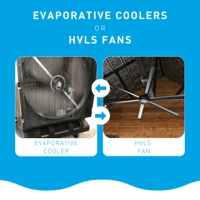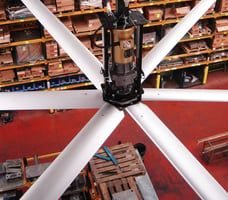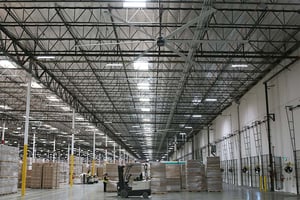Evaporative coolers, also known as swamp coolers, have long been a popular choice for cooling...
HVLS Fan Comparison: Dry vs. Humid Climates
Every facility is impacted in some way by its geographic climate. From the dry desert heat in the southwestern U.S. to the frigid cold that envelopes the northeast for much of the year, the weather has a big impact on a building's temperature. Consequently, this affects the comfort of its occupants. Are there some regional climates where HVLS fans are more effective than others? To find out, let's do an HVLS fan comparison on how one would typically function in a dry climate versus a humid climate.
HVLS Fans in Dry Climates
Dry climates in the U.S. are most prevalent in the southern and western regions of the country. These areas tend to have extremely hot summer and spring months, with annual average temperatures well into the 70 to 80-degree range.
Further complicating climate control in these regions is the fact that during the spring and fall seasons these areas tend to have drastic temperature fluctuations. In the Mojave Desert, for example, the maximum mean temperature for October is 87 degrees, while the minimum mean is 55 degrees.
In dry climates, HVLS fans can:
- Make employees more comfortable by creating a constant airflow
- Cut down on high summer cooling costs for large industrial buildings
- Make an HVAC system more effective through even dispersal
HVLS Fans in Humid Climates
Humid regions of the U.S. include southern states like Florida and Mississippi. In these areas, summer months are usually hot and sticky while the winters are mild and cool.
High humidity levels present several climate control challenges. Buildings in these areas are very susceptible to moisture damage and mold. Additionally, the high level of moisture in the air makes it more difficult for the human body to cool itself through sweating.
In humid regions, HVLS fans:
- Help prevent moisture-related problems like Sweating Slab Syndrome
- Supplement HVAC systems by better circulating climate-controlled air
- Increase personal comfort by reducing perceived heat and humidity
Final Comparison: Where are HVLS Fans Best?
HVLS fans have unique benefits for both dry and humid climates. Dry climates benefit most from the airflow’s ability to expedite the body’s evaporative cooling process. In humid regions, HVLS fans protect buildings and assets by minimizing mold, rust, and slippery surfaces and increasing human comfort levels. The versatility and benefits of HVLS fans can be felt in any climate or setting.


